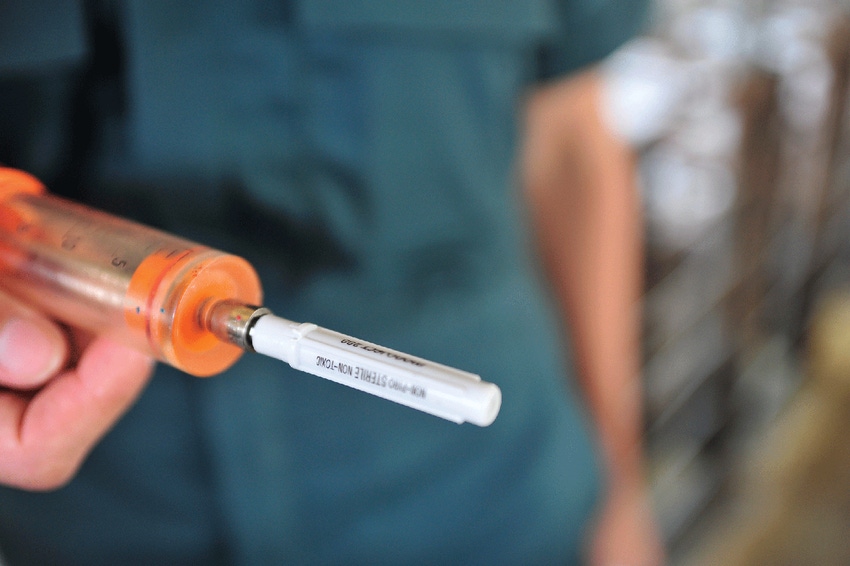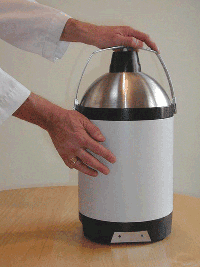The do’s and don’ts of needle disposal.

One of your co-workers comes to you and mentions that he just stuck himself with a needle containing a swine vaccine combination. He asks if this could be a problem.
How do you respond?
a. Don’t worry, it’s for pigs and won’t affect you.
b. Hmm … maybe you should get some antibiotics.
c. Probably, you should just get a tetanus shot.
d. I have no clue.
According to Jeff Bender, professor at the School of Public Health and College of Veterinary Medicine, University of Minnesota, and co-director of the Upper Midwest Agricultural Safety and Health Center, “d” is often the most popular response.
“Needlestick injuries are common, especially in agriculture settings and in swine settings,” Bender says. “There are a really limited number of documented cases in the literature, but some of these can be serious — and there is a real need for us to be aware of the issue and take precautions.”
While injuries can be minor, needlesticks can cause skin infections, allergic reactions and sometimes deep-tissue wounds that require surgery. That’s why the National Pork Board has dedicated resources to training and educating the industry on “Needle Know-How.” The concept not only addresses effectively administering injections but also broken needle prevention, animal handling, proper needle disposal, treatment records and reporting of broken needles, as well as creating awareness around proper medication management.
While there is very little data available to track the occurrence of broken needles in the industry, Karen Hoare, director of Producer Learning and Development at NPB, says there is still a risk for a broken needle to reach the finished pork market.
“While the risk is small, especially considering the number of injections given across the industry on an annual basis, the impact of one needle reaching the consumer or the retailer could be far-reaching and significant,” Hoare says. “It would impact markets and it would impact consumer trust.”
Broken needles and needlestick injuries often occur when a pig that is being vaccinated or treated suddenly jumps or moves. Bender says implementing a comprehensive needlestick prevention program on farm is crucial and should include the following practices.
For employees
Slow down — don’t rush with injections.
Restrain animals properly. Get help from coworkers. Use the correct equipment and techniques.
Don’t put needle caps in your mouth. Don’t carry needles or syringes in your pockets.
Discard bent needles — don’t use or straighten.
Use approved sharps containers. Don’t remove needles from a sharps container.
Don’t recap needles.
Report all needlestick injuries to management, and contact your healthcare provider.
For management
Train employees in safe needle handling and injection procedures, as well as the type of drugs used. Routinely retrain employees to reinforce safety procedures.
Provide safe animal handling equipment, and ensure proper staffing.
Provide readily accessible sharps container for safe needle disposal.
Provide needles or syringes with protective devices, such as retractable needles or hinged syringe caps.
Remind employees to use caution when using products of concern. Employees should not rush, and pregnant employees should not inject hormones.
Encourage employees to report injuries and contact a healthcare provider.

Next in needle disposal: The Medical Waste Machine
With the increased costs of medical waste removal, a Massachusetts-based company says it has a solution.
“With our system, nothing leaves your site as regulated waste, because it is all sterilized, reduced in size by 70% and goes in the trash as ordinary waste,” says David Freedman, Medical Innovations president.
Medical waste must be picked up on a regular basis from hospitals, dental clinics, veterinary clinics and livestock operations, and there are only a few pickup companies that offer these services. Through a heat sterilization process, the Medical Waste Machine converts sharps such as needles, syringes, blades, broken glass and other regulated medical waste into ordinary trash on-site. Freedman says the end product looks more like a hockey puck.
Since the containers used in the machine are sterilized in the process, it allows them to be used repeatedly and can eliminate the need for plastic containers for sharps.
According to Freedman, the system can save small and large businesses up to 80% yearly.
“We’ve seen anywhere from 25% savings to 150% savings,” Freedman says. “We had someone sign up who said the system will pay for itself in six months.”
Freedman says the Medical Waste Machine system also improves the liability situation, because there are no sharps and other medical waste on-site that need to be picked up.
“By saving the farms money, eliminating their liability — for which they are responsible forever — eliminating their paperwork and improving the environment, the Medical Waste Machine offers an unequivocal number of advantages over medical waste carriers and mail-back services,” Freedman says.
Click here for more information.
About the Author(s)
You May Also Like





